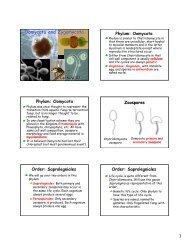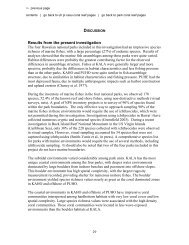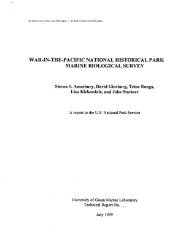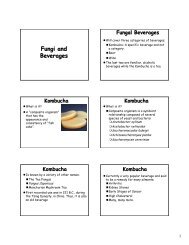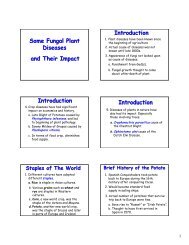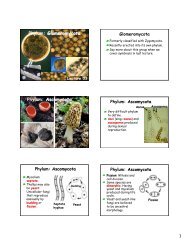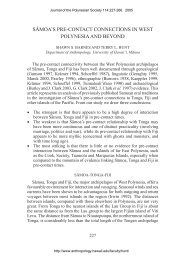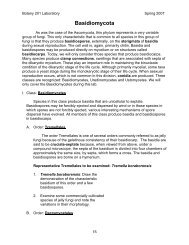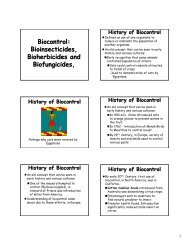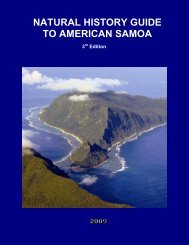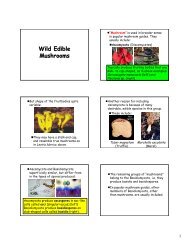american samoa - University of Hawaii at Manoa Botany Department
american samoa - University of Hawaii at Manoa Botany Department
american samoa - University of Hawaii at Manoa Botany Department
- No tags were found...
You also want an ePaper? Increase the reach of your titles
YUMPU automatically turns print PDFs into web optimized ePapers that Google loves.
WETLAND VEGETATIONNovember 1999 SurveyArt Whistler <strong>of</strong> Isle Botanica conducted a botanical survey <strong>of</strong> the Fusi wetland on November 9,1999. Mr. Whistler was part <strong>of</strong> a three-person field survey team organized by PedersenPlanning Consultants th<strong>at</strong> observed wetland veget<strong>at</strong>ion, habit<strong>at</strong> for aqu<strong>at</strong>ic fish andinvertebr<strong>at</strong>es, stream hydrology, as well as land uses within and adjacent to the wetland. Hisobserv<strong>at</strong>ions are summarized in the following paragraphs.The north and west boundaries <strong>of</strong> the wetland are covered with disturbed veget<strong>at</strong>ion anddomin<strong>at</strong>ed by alien weeds. The south side <strong>of</strong> the wetland represents secondary forest/plant<strong>at</strong>ionth<strong>at</strong> is associ<strong>at</strong>ed with an occupied house site.The underlying soils <strong>of</strong> the wetland contain a significant volume and wide variety <strong>of</strong> solidwaste m<strong>at</strong>erial. Much <strong>of</strong> the m<strong>at</strong>erial was apparently hauled to this site in the afterm<strong>at</strong>h <strong>of</strong>Hurricane Val in December 1991.Fresh-W<strong>at</strong>er SwampMost <strong>of</strong> the site was covered with a thicket <strong>of</strong>fau (beach hibiscus). The dominance <strong>of</strong> thisspecie and s<strong>at</strong>ur<strong>at</strong>ed soils indic<strong>at</strong>e th<strong>at</strong> thiswetland should be classified as a fresh-w<strong>at</strong>erswamp. Beach hibiscus was the only m<strong>at</strong>uretree found over most <strong>of</strong> the wetland. However,saplings <strong>of</strong> lowland forest trees such as maotamamala (Dysoxylum samoense), afa(Neonauclea forsteri), nonu (Indian mulberry),and oa (Bisch<strong>of</strong>ia javanica) were also present.The perimeter <strong>of</strong> the wetland was domin<strong>at</strong>ed bydisturbed areas and secondary scrub.The surface <strong>of</strong> the swamp was rel<strong>at</strong>ively devoid <strong>of</strong> veget<strong>at</strong>ion. The most common species wassa<strong>at</strong>o (swamp fern), which probably covered less than five percent <strong>of</strong> the ground. Otherground cover species included marsh fern (Cyclosorus interruptus) and umbrella sedge(Cyperus alternifolius), as well as many other species observed only once or twice. The mostcommon epiphyte was the fern lau magamaga (Phym<strong>at</strong>osorus grossus) and lesser amounts <strong>of</strong>laugapapa (bird’s nest fern).The adder’s-tongue fern (Ophioglossum reticul<strong>at</strong>um), which was listed as a rare plant <strong>of</strong>concern in a recent U.S. Fish and Wildlife Service survey, was found in the fresh-w<strong>at</strong>er swampon several low, moss-covered mounds or rock outcroppings. This species is known inAmerican Samoa only from several collections in the higher elev<strong>at</strong>ions <strong>of</strong> Laufuti Stream onthe south side <strong>of</strong> Tau, as well as from a single collection on Tutuila around 1860.Disturbed MarshThe southern part <strong>of</strong> the wetland is a disturbed marsh. Immedi<strong>at</strong>ely adjacent to the beachhibiscus thicket is a disturbed marsh th<strong>at</strong> is domin<strong>at</strong>ed by fue saina (mile-a-minute vine),willow primrose (Ludwigia octovalvis), as well as lesser amounts <strong>of</strong> pasio vao (love-in-a-mist)and palulu (Stictocardia tiliifolia). Fue saina and willow primrose are characteristic <strong>of</strong>wetlands; the l<strong>at</strong>ter two weed species are not.American Samoa Wetlands/Streams Restor<strong>at</strong>ion and Enhancement PlanFebruary 2001, Fusi Wetland, Page 11-4



